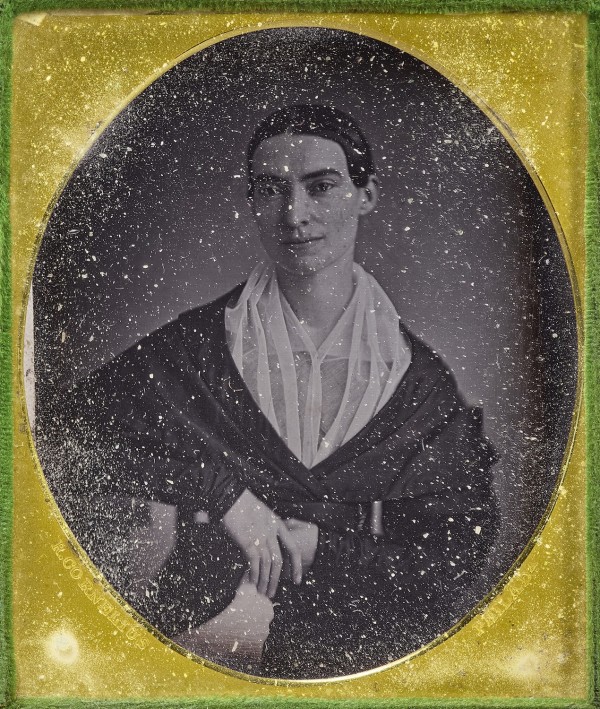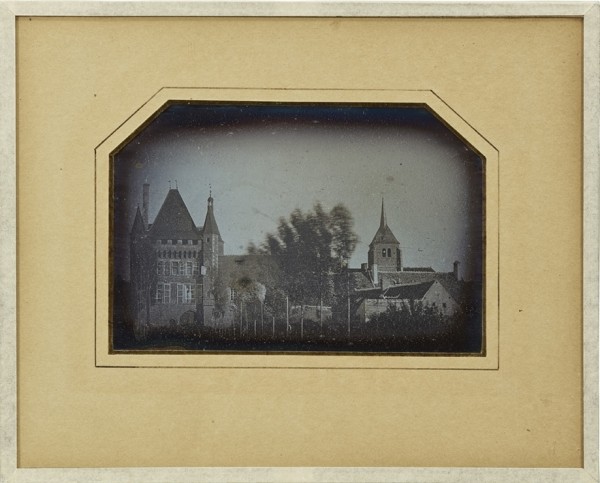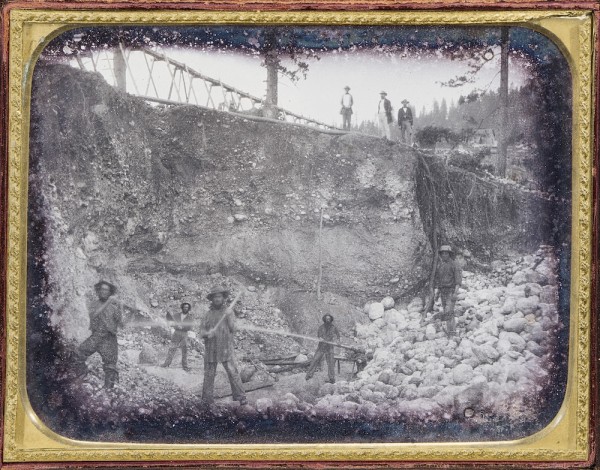Legendary Art and Photography Collector Sylvio Perlstein Has Died
Artist Dan Marcolina’s "Diffused Reality" Is on Exhibition
Summer Sale Only has One Month to Go Here with 30% Off on Nearly 3,500 Photographs
And a Last Note

Robert Cornelius: Portrait of a Woman, c. 1840–41, sixth-plate daguerreotype ($3,000–$5,000), was the top lot at $60,480 at Christie’s online sale of the Maillet Daguerreotype Collection.
Christie's sale of the Maillet Daguerreotype Collection, the most important sale of daguerreotypes in 25 years, online through June 26, totaled a substantial $1,618,722 with a minuscule 4.2% buy-in rate. However, prices were all over the place (from more than $60,000 to $126) as was the quality of material from condition, to historical importance, to certainty of some attributions and dates (especially some of the 1839-40 dates), to contemporary interest in subject matter.
Of the 265 lots on offer only 11 bought in, but they included some of the most expensive estimated lots, and only 39 lots sold within their estimates. Remembering that the estimates do not include the buyer's premium but the sales total does (a figure I think Christie's fudged a bit in saying the sale was 93% sold by value), look at how most of the lots did:
Lots sold over estimate = 48
2x over estimate = 20
3x over estimate = 16
4x over estimate = 8
5x over estimate = 6
6x over estimate = 2
8x over estimate = 1
9x over estimate = 2
17x over estimate = 1
Lots sold under low estimate = 88
2x under low estimate = 7 (meaning the sale price
was half or less of the low estimate, etc.)
3x under low estimate = 12
4x under low estimate = 3
8x under low estimate = 1
That's 104 lots that sold over estimate and 111 lots that sold under estimate. You don't see that
every day--or ever.
Prices cited below include Christie's 26% buyer’s premium.
According to Christie's: "The sale attracted strong global interest, with 51% of bidders and buyers new to Christie's Photographs category--underscoring the magnetic appeal of early photographic processes to a growing and diverse collecting audience.
Darius Himes, Christie's International Head of Photographs, remarked: "It has been a privilege to steward this remarkable collection--undoubtedly one of the most significant holdings of daguerreotypes to come to market in the past 25 years. The Maillets collected with passion, insight, and unwavering dedication, assembling a collection of exceptional depth and quality. The breadth of their vision stands as a testament to their connoisseurship and lifelong commitment to this singular medium."

Albert Stapfer: Chateau de Talcy, 14 October 1840 ($15,000–$20,000), took third place at Christie’s at $40,320.
"The top lot of the sale was Portrait of a Woman, c. 1840-41 by Robert Cornelius, which sold for $60,480--an impressive 20 times its low estimate [actually 17 times--the estimate was a true misreading of the market for such an important image], highlighting the strength of the market for historic and rare photographic works. Additional top lots include a group of works by Haiti-born Francis H. Grice, a Black American daguerreotypist, which sold for $40,320 [a group lot of twenty-one portraits, c.1845, 21 daguerreotypes, two quarter-plates, two ninth-plates, and 17 sixth-plates, cased, some with hand-tinting, each with embossed photographer's credit (recto) ($50,000–$70,000)]; a rare view of a Gold Mining Camp, c. 1850, which realized $37,800; along with Albert Stapfer's Chateau de Talcy, 14 October 1840, which realized $40,320 [($15,000–$20,000) and third place]; and a rare medallion style portrait by Southworth & Hawes, realizing $32,760 [($30,000–$50,000) and selling just under estimate]."
Actually, several people I reached out to questioned the attribution to Grice, and one was surprised it sold at all and wondered if the buyer would return the lot or ask for a substantial discount; if, this person speculated, it had really sold at all. I have no evidence that it didn't sell.
Others questioned the attribution of several of the pictures credited to Southworth & Hawes.
And there were more questions on attributions. Terry Alphonse, who has the largest collection of Jeremiah Gurney images in the world yet eschews the title of Gurney "expert," but clearly may know more about Gurney than anyone else alive, and is often consulted by others, appreciated the great depth of Maillet's collection. However, he informed Christie's that lot 127, Portrait of Three Children, Girls in Lace Mitts, c. 1850, whole-plate daguerreotype, was clearly not a Gurney.
Alphonse wrote, "The only props to compare with lot 127 would be those from other 707 Broadway examples [Gurney's third studio, c. 1859–60] of which I said would be found in any of my hundreds of other daguerreotypes, CDVs, cabinet cards, stereoviews, etc. Unfortunately, they do not." And "[T]he mat and case are real, and from Jeremiah's 707 Broadway studio, but the image or daguerreotype plate is not. It is a marriage of a non-Gurney image with a Gurney mat and case presentation."
After three weeks of back and forth, Christie's said they couldn't change the cataloguing.
Alphonse said that if it were really a Gurney, he would have been going after it as it would have been the first whole plate by Gurney to appear at auction. All the other whole plates are in institutional collections.

Unknown Photographer: Use of Hydraulics at a California Gold Mine, c. 1851, half-plate daguerreotype, cased ($12,000–$18,000) sold over estimate for $44,100 and took second place at Christie’s.
How attributions adhere to old pictures is often lost in the fog of time, and Maillet may well have believed the attributions when he first obtained the images in the 1970s, before increasing sophistication and connoisseurship developed along with the photography market. And Christie's may have acted in good faith in accepting the attributions. Nonetheless, it would have been better for all involved if Christie's had taken more time and involved the expertise of the broad daguerreian community.
An other bidder Californian Tim Lindholm told us, "The sale was really all over the place. Some estimates were way too low, some (on bad stuff) too high. The higher end, the more aspirational the opening bids. The opening bids were the reserves. I had spent tons of times analyzing and strategizing. I came expecting to spend real money, but so much blew past what I was expecting. I chased a number of things into crazy town and still lost them.
"I ended up with the oddly tinted black nanny with the baby (not PM), the early Beard quarter plate of the woman looking back at her baby on a chair (also not PM), and the super-tinted gravestones in summer and fall (definitely PM!!!)."
Lindholm also mentioned that he had underbid the early Stapfer Chateau de Talcy plate that breached the $40,000 mark.
Another gold-mining scene did very well and took second place in the sale: Use of Hydraulics at a California Gold Mine, c. 1851, by an unknown photographer, half-plate daguerreotype, cased ($12,000–$18,000) that sold over estimate for $44,100.
A Portrait of a Young Actor, Believed to Be John Wilkes Booth, Wearing a Shakespearean Costume, c.1855, by an unknown photographer, half-plate daguerreotype, cased, hinge broken, with hand-tinting ($40,000–$60,000), emoted to $35,280. This image came from the collection of Josephine Cobb, the legendary archivist and historian. As quoted in the lot essay, "According to the Maillets, Cobb's hesitancy to disclose the true identity of the sitter was one of embarrassment. 'She was ashamed,' recalled Yann Maillet, 'and as a well-known Lincoln scholar, she didn't want to appear to be glorifying Booth or his horrendous act.'" However, people who knew Cobb scoffed at the idea that she would be ashamed of this image. Maybe it's Booth, maybe not. There is sometimes a thin line between history and mythology.
I contacted several experts in the field including some who bought some images in the sale. Keith Davis, the long-time curator at the Hallmark Collection and then the Nelson-Atkins Museum, and one of the few people to have seen the collection, reported that he bought about 40 plates from Maillet for the Hallmark Collection, which later went to the Nelson-Atkins Museum, in 1995, and perhaps another 10 in 1996–97, often paying top dollar. (The Nelson-Atkins was one of the institutions that were successful buyers in the sale.)
Davis agreed there was some prime material and that Maillet was so secretive that these images were really new to the market, though noting that the market has deflated in the last decade.
Davis praised Maillet for his "admirable ruthlessness." He quoted Maillet as once saying, "If the devil had a great daguerreotype, I'd find a way to do a deal with the devil." He described Maillet as tough, but that for him personalities didn't matter or who owned a daguerreotype he wanted. It was all about the piece.
Davis opined that there were bargains and many fair prices in the sale, again commenting that even though the gold mining scenes often sold over estimate, prices were still lower than in past years.
April Watson, the current Nelson-Atkins Curator of Photography, noted that the museum picked up an additional four images from the Maillet auction, including the Portrait of A.W. Fagins, the “Millionaire Miller” of St Louis, Missouri (lot 9); the Southworth & Hawes, a full-plate of Medallion of a Young Woman (lot 20); the City Hall, Havana, Cuba, which is attributed to Charles Deforest Fredricks (lot 44); and a full plate of Babbitt's Pavilion Covered in Snow, Niagara (lot 54).
Watson did tell us, "Obviously some terrific pieces. Some of the key pieces were priced too high though. But I'm sure that you have heard that from others."
In response to my questions, collector Michael Mattis wrote: "Judy and I never met Yann and Lynn Maillet, as their period of activity in the daguerreotype market long preceded our own interest in that field--but we had certainly heard rumors of their extraordinary and highly eclectic holdings. Like just about every major frozen-in-amber fresh-to-market art or antiques collection that appears on the auction block, it inspired phenomenal bidding wars across its numerous areas of strength. As additional catnip, following the custom of many Paris auction houses, Christie's slyly posted temptingly low estimates with much-lower-still opening bids--often just $100. In sharp contrast, the half-dozen high-end pieces for which Yann had insisted on above-retail estimates got spanked. And I should also note a caveat emptor quality to the sale, as the consignors sometimes had overly optimistic attributions. On balance, I would characterize the bidding as 'rational exuberance.'
"As for ourselves, Judy and I bid on 35 lots and were successful on 16, including our two priorities: the tiny ninth-plate Samuel Morse (which had descended in the family of Samuel Walker, who was said to be Morse's first assistant in daguerreotypy in 1839-40) [($40,000-$60,000), at $32,760]; and the whole-plate Spanish occupational, Two Matadors [($20,000-$30,000), at $35,280]. We were also delighted to acquire the dentist-with-patient occupational [($1,200-$1,800), at $21,420]; the locomotive "Dunkirk" [($2,000-$3,000), at $16,380]; the Mayhew of Fort Gibson, OK [with a Portrait of General William Goldsmith Belknap, Commander of Fort Gibson, ($20,000-$30,000), at $27,720]; the pair of circular quarter-plate harbor views of Corsica [($6,000–$8,000), at $25,200]; and the "Amah" (Chinese nanny) with infant [($2,000–$3,000), at $10,710]."
It was unclear to several others I spoke with that the big disparity in bids both above and below the estimates was a clever ruse by Christie's to encourage bidding (if so, why so many final bids below the low estimates?) or a lack of understanding of the daguerreotype market on the part of Christie's and its consultants.
Collector/dealer Michael Lehr was one of the more active bidders as he bought 26 lots totaling about $113,000 from the sale, some for clients, some for his collection, and some to resell in his auctions.
The top five highest estimated lots in the sale--the first three attributed to John Ruskin: View
Towards Fiesole, Florence, c. 1846, European half-plate daguerreotype ($150,000–$250,000);
San Miniato al Monte, Florence, c. 1846, European half-plate daguerreotype ($100,000–$150,000); and Tower of Giotto, Florence, c. 1846, European half-plate daguerreotype ($80,000–$120,000); and Francisco De Leygonier's La Giralda Cathedral, Seville, Spain, 1848, whole-plate daguerreotype ($80,000–$120,000); and Henry Fitz Jr's or John Plumbe Jr's Washington Monument, Baltimore, 1841, whole-plate daguerreotype, ($60,000–$80,000)--all failed to sell. (The attribution originally to Fitz was changed to add Plumbe after several knowledgeable people sent research questioning the original attribution.
There was talk that Yann Maillet insisted on the high estimates and reserves (sadly he died
right before the sale), but someone else reported that Christie's head of photographs Darius Himes argued that some very high estimates were needed to attract ultra-wealthy bidders. If true, that stratagem definitely didn't work and was a bit of a fool's errand to attract people without a true understanding of daguerreotypes, which have a detailed history and a somewhat esoteric market.
And one other expert thought the online illustrations were very uneven--some excellent and others poor--and wondered if that may have affected the bidding. I'm not sure how many people bid without previewing in person or having a trusted surrogate preview for them, but this was a sale where the objects really needed to be seen in person.
Lastly, one bidder not from the East Coast said they bought two lots with four sixth-plates for about $2,000 but was rather taken aback when Christie's told him that shipping by FedEx would cost $630! After some back and forth he just had a friend pick up the lots for him and sent them on for a reasonable price. (Editor's note: actually for Christie's that was an inexpensive shipping quote. Both big NYC auction houses are known for their outrageous shipping quotes.)
So what have we learned? I guess we shouldn't fault a poor little auction house for trying. The sale did decently well, but Christie's, which has not handled significant daguerreotypes in decades, did not have the deep knowledge needed, nor perhaps enough time, to resolve many of the questions about attribution and dating--or to challenge some of the information provided by Maillet. Now that these fascinating objects are out in the world again, we may eventually answer some of these questions with the collective knowledge of the daguerreian community brought to bear.
My thanks to Steve Perloff and The Photograph Collector Newsletter for giving me permission to use this information. The Photograph Collector, which is a wonderful newsletter that I can heartily recommend, is published monthly and is available by subscription for $149.95. You can phone 1-215-891-0214 and charge your subscription or send a check or money order to: The Photograph Collector, 340 East Maple Ave., Suite 200, Langhorne, PA 19047. Or to order The Photograph Collector Newsletter online, go to: https://photoreview.org/publications/the-photograph-collector/.
Legendary Art and Photography Collector Sylvio Perlstein Has Died
Artist Dan Marcolina’s "Diffused Reality" Is on Exhibition
Summer Sale Only has One Month to Go Here with 30% Off on Nearly 3,500 Photographs
And a Last Note


Share This